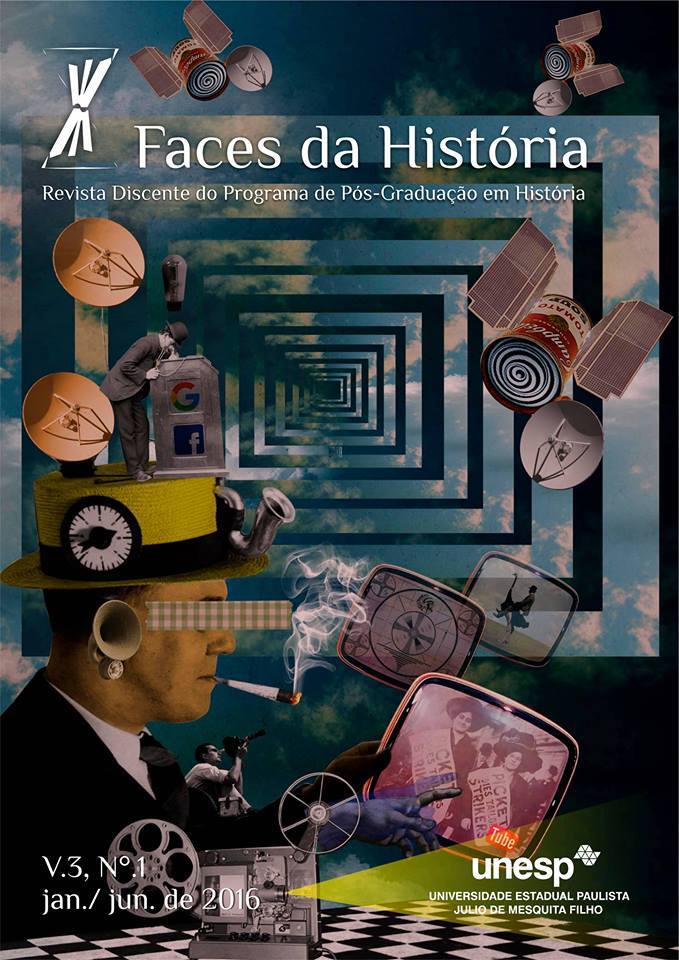Da história instantânea ao arquivo infinito
arquivo, memória e mídias eletrônicas a partir do Center for History and New Media (George Mason University, EUA)
Palabras clave:
Memória – Internet – Arquivo – Cultura de massa – Evento modernista – Passado práticoResumen
O presente artigo tem como objetivo refletir acerca da interrelação entre tecnologias digitais, mídia e experiência histórica. Para isso, estuda-se dois arquivos digitais desenvolvidos pelo Roy Rosenzweig Center for History and New Media (CHNM), centro de estudos criado em 1994 na George Mason University, nos Estados Unidos. Esses arquivos, relacionados aos eventos de 11 de setembro e a passagem do furacão Katrina, respectivamente, trazem indagações a respeito da relação entre vivência histórica e o uso dos registros históricos. Mais especificamente, eles parecem dissolver o contínuo histórico numa série de elementos discretos - os registros históricos midiáticos -, rechaçando a possibilidade de um entendimento narrativo do passado. Essa recusa da narrativa os aproxima da reflexão sobre a representação dos eventos traumáticos contemporâneos; desse modo, procura-se mostrar como os arquivos digitais do CHNM podem ser estudados à luz dos debates contemporâneos acerca da
memória e da escrita da história.
Citas
ASSMANN, Aleida. Espaços da recordação: formas e transformações da memória cultural. Campinas: Editora da UNICAMP, 2011.
ASSMANN, Aleida. The Holocaust as Global Memory? Extensions and Limits of a New Memory Community. In: ASSMANN, Aleida; CONRAD, Sebastian. Memory in a Global Age: Discourses, Practices, and Trajectories. New York: Palgrave Macmillan, 2010, p. 97-117.
ASSMANN, Aleida; CONRAD, Sebastian. Memory in a Global Age: Discourses, Practices, and Trajectories. New York: Palgrave Macmillan, 2010.
BOLTER, Jay David; GRUSIN, Richard. Remediation: Understanding New Media. Cambridge, Mass.: The MIT Press, 2000.
BOYD, danah m.; ELLISON, Nicole B. Social Network Sites: Definition, History, and Scholarship. In: Journal of Computer-Mediated Communication, 13, 2008, p. 210-230.
BRENNAN, Sheila A.; KELLY, T. Mills. Why Collecting History Online is Web 1.5. In: Roy Rosenzweig Center for History and New Media, 2009, disponível em https://chnm.gmu.edu/essays-on-history-new-media/essays/?essayid=47
COHEN, Daniel. The Future of Preserving the Past. In: CRM: The Journal of Heritage Stewardship 2, 2 (summer 2005), p. 6-19, disponível em http://chnm.gmu.edu/essays-on-history-newmedia/essays/?essayid=39
COHEN, Daniel; ROSENZWEIG, Roy. Collecting History Online. In: ROSENZWEIG, Roy. Clio Wired: The Future of the Past in the Digital Age. New York: Columbia University Press, 2011, p. 124-154.
DERRIDA, Jacques. Mal de Arquivo – Uma Impressão Freudiana. Rio de Janeiro: Relume Dumará, 2001.
DOSSE, François. Renascimento do acontecimento. São Paulo: Editora UNESP, 2013.
FELMAN, Shoshana. The Juridical Unconscious: Trials and Traumas in the Twentieth Century. Cambridge, Mass.: Harvard University Press, 2002.
FLÓREZ, Jairo Antonio Melo. Historia digital: la memoria en el archive infinito. In: Historia Critica, Bogotá, n° 43, enero-abril 2011, p. 82-103.
FOGU, Claudio. Digitalizing Historical Consciousness. In: History and Theory, Theme Issue 47, May 2009, p. 103-121.
GOPNIK, Adam. Stones and Bones. In: New Yorker, July 7th, 2014, disponível em http://www.newyorker.com/magazine/2014/07/07/stones-and-bones
HARTOG, François. Regimes de Historicidade: Presentismo e Experiência do Tempo. Belo Horizonte: Autêntica, 2014.
HUYSSEN, Andreas. Presents Pasts: Urban Palimpsests and the Politics of Memory. Stanford: Stanford University Press, 2003.
KITTLER, Friedrich. Gramophone, Film, Typewriter. Stanford: Stanford University Press, 1999.
KOSELLECK, Reinhart. War Memorials: Identity Formations of the Survivors. In: The Practice of Conceptual History. Stanford: Stanford University Press, 2002, p. 285-325.
LANDSBERG, Alison. Prosthetic Memory: The Transformation of American Remembrance in the Age of Mass Culture. New York: Columbia University Press, 2004.
LORENZ, Chris. Blurred Lines: History, Memory and the Experience of Time. In: International Journal for History, Culture, and Modernity, Amsterdam, 2014, vol. 2, n° 1, p. 43-62.
LORENZ, Chris. It Takes Three To Tango. History Between the ‘Practical’ and the ‘Historical’ Past. In: Storia della Storiografia, vol. 65, no 1, 2004, p. 29-46.
MANOVICH, Lev. The Language of New Media. Cambridge, Mass.: The MIT Press, 2001.
MÉTRAUX, Alexandre. Authenticity and Authority – On Understanding the Shoah. In: STRAUB, Jürgen (ed.). Narration, Identity, and Historical Consciousness. New York/Oxford: Berghahn Books, 2005, p. 228-244.
MUDROVCIC, María Inés. About lost futures or the political heart of history. In Historein, vol. 14, no 1, 2014, p. 7-21.
PAUL, Herman. Hayden White. Cambridge: Polity Press, 2011.
PONS, Anaclet. Guardar como. La historia y las Fuentes digitales. In: Historia Critica, Bogotá, n° 43, enero-abril 2011, p. 38-61.
RICOEUR, Paul. Tempo e Narrativa. São Paulo: Martins Fontes, 2010, vol. I.
REYNOLDS, Simon. Retromania: Pop Culture’s Addiction To Its Own Past. London: Faber & Faber, 2011.
ROSENZWEIG; Roy; THELEN, David. The Presence of the Past: Popular Uses of History in American Life. New York: Columbia University Press, 1998.
WHITE, Hayden. El pasado práctico. In TOZZI, Verónica; LAVAGNINO, Nicolás (orgs). Hayden White, la escritura del pasado y el futuro de la historiografía. Sáenz Peña: Universidad Nacional de Tres de Ebrero, 2012, p. 19-39.
WHITE, Hayden. The Historical Event. In: The Practical Past. Evanston, Illinois: Northwestern University Press, 2014, pp. 41-62.
WHITE, Hayden. The Modernist Event. In: Figural Realism: Studies in the Mimesis Effect. Baltimore: The Johns Hopkins University Press, 1999, p. 66-86.
WHITE, Hayden. The Value of Narrativity in the Representation of Reality. In: The Content of the Form: Narrative Discourse and Historical Representation. Baltimore: The Johns Hopkins University Press, 1987, p. 1-25.
Publicado
Cómo citar
Número
Sección
Licencia
Autores que publicam na Revista Faces da História concordam com a cessão dos direitos autorais dos manuscritos, processo simultaneamente licenciado sob a Licença Creative Commons Attribution (CC-BY-NC), que permite o compartilhamento do trabalho com reconhecimento da autoria e publicação inicial nesta revista. Dessa forma, a Revista Faces da História pode difundir os artigos e trabalhos publicados, em formatos físicos e/ou eletrônicos, incluindo Internet.




